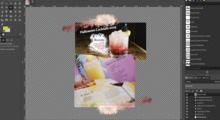Peter's single-window proposal (Was: We should go for a single-window mode in 2.8)
This discussion is connected to the gimp-developer-list.gnome.org mailing list which is provided by the GIMP developers and not related to gimpusers.com.
This is a read-only list on gimpusers.com so this discussion thread is read-only, too.
Peter's single-window proposal (Was: We should go for a single-window mode in 2.8)
I'm not planning to dive deeply into this discussion, but I feel that Peter's blog deserves its own thread.
Now my comment:
Peter wrote:
I have really to ask what you expect from that float image, and how different
that would be from multi-widow mode.
I don't know an answer to this, so I'm going to pont to one of the brainstorm images that Peter shows on his blog: The one with the split image window (third in the center column).
It still is a single window, with all toolbars, docks, etc. fit closely in. But it has some advantages of multiple windows: You can work on two images simultaneously, as needs to be done when comparing two images, repetitive copy&paste between the two, cloning with one image as the source and the other (active) as the target, etc. Dragging&dropping from the history would work intuitively as well, closing one view would simply expand the other window to full size again, but I'm happy to leave the details to others.
As I said, I don't have that much time at the moment..
Cheers, Daniel
Peter's single-window proposal (Was: We should go for a single-window mode in 2.8)
Daniel Hornung wrote:
I'm not planning to dive deeply into this discussion, but I feel that Peter's
blog deserves its own thread.
OK, I am picking up the thread here.
as I just commented on the blog post, I am going to address this need
for
windows-in-window and work-side-by-side structurally.
this means first finding out the user requirements behind these requests.
so for everybody who feels this: _why_ do you need windows-in-window or work-side-by-side?
Jolie and Daniel already had their say and it is noted, but I want have the complete picture before adjusting the plan (or not).
so let me know...
--ps
founder + principal interaction architect man + machine interface works
http://mmiworks.net/blog : on interaction architecture
Peter's single-window proposal (Was: We should go for a single-window mode in 2.8)
this means first finding out the user requirements behind these requests.
so for everybody who feels this: _why_ do you need windows-in-window or work-side-by-side?
I've been reading both the blog posts, and the many discussions here on the mailing list, mainly as an interested user of Gimp.
Here are the main reasons I work with two images fully open at one time:
- sampling colours from one image to use in another other. (I have a number of palette images I keep around for this purpose. I know I could just create real .pal files from them, but I like to be able to have the colours spatially distributed the way I like...) - cutting and pasting areas/selections from one image into the other - cloning from one image to another (auto-scroll would be nice, here).
I also like to work with two views of the same image at different zoom ratios, depending on the work I am doing (details drawing, usually). This includes zoomed in cutting and pasting or cloning of areas that are far apart.
That being said, I believe I would continue to work with the current multi window layout, mainly because I am used to it...
-Rob A>
Peter's single-window proposal (Was: We should go for a single-window mode in 2.8)
On Sunday 20 September 2009, peter sikking wrote:
so for everybody who feels this: why do you need windows-in-window or work-side-by-side?
First of all a great idea to get some more feedback.
I have one thing for which I had wished for side by side windows recently:
When working on the layer mask of an image. There I would have very much liked
to have the background layer, the top level layer and it's layer mask each
side by side so that I could have judged where I was changing something and
which effect it has immediately. It would have saved the me endless number of
switches between the different views I needed to complete my editing...
This may be something different than what you are proposing but if at all
possible within the framework to have different layers and or layer masks in
side by side windows would IMHO help me much!
regards
Karl Günter
Peter's single-window proposal
third try, the list should be undead now:
OK, comments have petered out here (yeah, dead list) and on the blog post.
So it is time for me to summarise the users' needs I was able to filter out of them:
1) drag a layer to another image
2) side-by-side working for
- cloning
- color picking
- repetitive copy and paste
- synchronising working a set of images, keeping them
artistically together as a set (a deep one, this one)
- working on the same image, different layer composition, zoom and/
or position
3) 'seeing the same', synchronised zooming and panning of 2 or more
images
4) work with numerous (15+) images at the same time
and that is it.
I will start thinking about how to address this now.
--ps
founder + principal interaction architect man + machine interface works
http://mmiworks.net/blog : on interaction architecture
Peter's single-window proposal
On Sep 27, 2009, at 3:53 PM, peter sikking wrote:
third try, the list should be undead now:
OK, comments have petered out here (yeah, dead list) and on the blog post.
So it is time for me to summarise the users' needs I was able to filter out of them:
1) drag a layer to another image 2) side-by-side working for
- cloning
- color picking
- repetitive copy and paste
- synchronising working a set of images, keeping them artistically together as a set (a deep one, this one) - working on the same image, different layer composition, zoom and/ or position
3) 'seeing the same', synchronised zooming and panning of 2 or more images
4) work with numerous (15+) images at the same timeand that is it.
I think I might have one that can count as subtly different.
Working on a prime image and drawing pieces, reference, etc from other images. Especially since I tend to think spatially, this is one I do a lot. I also tend to combine this workflow with others you have already listed.
Peter's single-window proposal
Jon A. Cruz wrote:
I think I might have one that can count as subtly different.
Working on a prime image and drawing pieces, reference, etc from other images. Especially since I tend to think spatially, this is one I do a lot. I also tend to combine this workflow with others you have already listed.
is this 'compare and reference' as fully covered by the polaroids?
--ps
founder + principal interaction architect man + machine interface works
http://mmiworks.net/blog : on interaction architecture
Peter's single-window proposal
Citing a passage regarding the "image parade" on Peter Sikking's blog post:
What I find very intriguing is that the notion of which file is open starts to blur. Having a file being loaded from disk becomes a side effect of clicking it to make it the current file. Similarly GIMP can decide to start closing files with no unsaved changes when there are too many of them open and memory gets tight.
My current thinking is that it is not necessary to mark files in the parade as being open. The concept quasi disappears for users. The white stars indicate unsaved changes.
It should be noted that many plug-ins and filters provide dialogs in which the user is prompted (via drop-down lists) to select images/layers/channels/paths from amongst those available in currently opened images. It would seem unwieldy for the code to have to open previously closed files to search for these potential images/layers/channels/paths every time such a dialog is presented (and the resulting drop-down lists could contain LOTS of entries in which the user holds no interest). Thus it may be necessary to retain the concept of "opened images" and provide a means of distinguishing unopened images in the image parade (if they are to be included).
Peter's single-window proposal
saul goode wrote:
Citing a passage regarding the "image parade" on Peter Sikking's blog post:
What I find very intriguing is that the notion of which file is open starts to blur.
It should be noted that many plug-ins and filters provide dialogs in which the user is prompted (via drop-down lists) to select images/layers/channels/paths from amongst those available in currently opened images. It would seem unwieldy for the code to have to open previously closed files to search for these potential images/layers/channels/paths every time such a dialog is presented (and the resulting drop-down lists could contain LOTS of entries in which the user holds no interest). Thus it may be necessary to retain the concept of "opened images" and provide a means of distinguishing unopened images in the image parade (if they are to be included).
you are pointing out a serious spanner in the works.
and if I do not find a way to houdini me out of that one, then that will be it for fuzzy...
--ps
founder + principal interaction architect man + machine interface works
http://mmiworks.net/blog : on interaction architecture
Peter's single-window proposal
On Monday 28 September 2009, saulgoode@flashingtwelve.brickfilms.com wrote:
It should be noted that many plug-ins and filters provide dialogs in which the user is prompted (via drop-down lists) to select images/layers/channels/paths from amongst those available in currently opened images. It would seem unwieldy for the code to have to open previously closed files to search for these potential images/layers/channels/paths every time such a dialog is presented (and the resulting drop-down lists could contain LOTS of entries in which the user holds no interest).
The point when the user can choose the desired "other image" does not require the full image, a name + thumbnail is all that's shown with the current implementation. If this requirement doesn't change, I don't see a problem. The thumbnails are there for the gallery anyway and the drop-down list could be just another instance/view of the very same gallery, maybe. Real access to the relevant image's content is only done when it's needed.
And the gallery's entries would be in roughly chronological order wrt the last showing time anyway, I suppose.
Cheers, Daniel
Peter's single-window proposal (Was: We should go for a single-window mode in 2.8)
peter sikking wrote:
so for everybody who feels this: _why_ do you need windows-in-window or work-side-by-side?
Personally, for me who I'm into drawing and digital painting (rather than photo retouching) I can think of these reasons:
- For multiple views of the same image at different zooms at the same
time. It's useful to have a zoomed window for detail work and then a
more extended view in order check often how the whole drawing / painting
looks.
- To have one or more images as reference to copy / get inspired by.
- To tests brushes, mix colors or trying anything else without affecting
the original image.
Peter's single-window proposal
On Sep 28, 2009, at 1:29 AM, peter sikking wrote:
Jon A. Cruz wrote:
I think I might have one that can count as subtly different.
Working on a prime image and drawing pieces, reference, etc from other images. Especially since I tend to think spatially, this is one I do a lot. I also tend to combine this workflow with others you have already listed.
is this 'compare and reference' as fully covered by the polaroids?
In some cases it might, but in many it does not. The lack of items such as the rulers, etc. tends to slow me down when I'm "constructing" something.
My impression is that the polaroids are an improvement for "inspired by" work, such as I often see designers hash out. Using a "reference" in my thinking brings a little more of the technical/accuracy aspect such as measurements with the ruler, etc.
Peter's single-window proposal
Jon A. Cruz wrote:
I think I might have one that can count as subtly different.
Working on a prime image and drawing pieces, reference, etc from other images. Especially since I tend to think spatially, this is one I do a lot. I also tend to combine this workflow with others you have already listed.
is this 'compare and reference' as fully covered by the polaroids?
In some cases it might, but in many it does not. The lack of items such as the rulers, etc. tends to slow me down when I'm "constructing" something.
My impression is that the polaroids are an improvement for "inspired by" work, such as I often see designers hash out. Using a "reference" in my thinking brings a little more of the technical/ accuracy aspect such as measurements with the ruler, etc.
OK, understood (also Akira, btw, thanks for more feedback)
I am working on split panes right now, for both single-and multi-
windows,
focussing on keeping the clutter (explosion of edges, handles, rulers,
scrollbars, title bars with close/minimise/maximise buttons) down
stay tuned,
--ps
founder + principal interaction architect man + machine interface works
http://mmiworks.net/blog : on interaction architecture
Peter's single-window proposal (Was: We should go for a single-window mode in 2.8)
SHIRAKAWA Akira wrote:
> peter sikking wrote:
>
>> so for everybody who feels this: _why_ do you need windows-in-window or
>> work-side-by-side?
>
> Personally, for me who I'm into drawing and digital painting (rather
than photo retouching) I can think of these reasons:
[cut]
If I may, I'd also like to add that I find absolutely necessary to maximize vertical space / resolution. It has become very precious resource lately as monitors are starting to adopt very squashed aspect ratios (16:10 was the normality until a few years ago, but recently 16:9 screens have been introduced with virtually no increase of vertical resolution despite the noticeable increase of horizontal one).
This means that personally I wouldn't put a 'polaroids' feature on top of the screen or adopt a blender-style interface as suggested in another thread (or at least the standard one, I haven't used that program much but I remember that the default 3d viewport is very wide with all tools and commands on the bottom).
Maximizing vertical space is especially important for digital tablets users, since most modern tablets are now in wide (16:10) format. A reduced vertical space forces the user to physically draw "small" on the tablet (implying very reduced hand movements), which for most artists is a bad thing. (that is, unless both the monitor and the tablet are set up to operate in portrait mode, but it's not a very practical thing to do, and most LCD monitors are not designed to work this way)
Peter's single-window proposal (Was: We should go for a single-window mode in 2.8)
Akira wrote:
If I may, I'd also like to add that I find absolutely necessary to maximize vertical space / resolution. It has become very precious resource lately as monitors are starting to adopt very squashed aspect ratios (16:10 was the normality until a few years ago, but recently 16:9
screens have been introduced with virtually no increase of vertical resolution despite the noticeable increase of horizontal one).
this was actually my topic and conclusion at my lgm talk a year and a half ago. that was never blogged, because of time constraints.
--ps
founder + principal interaction architect man + machine interface works
http://mmiworks.net/blog : on interaction architecture











